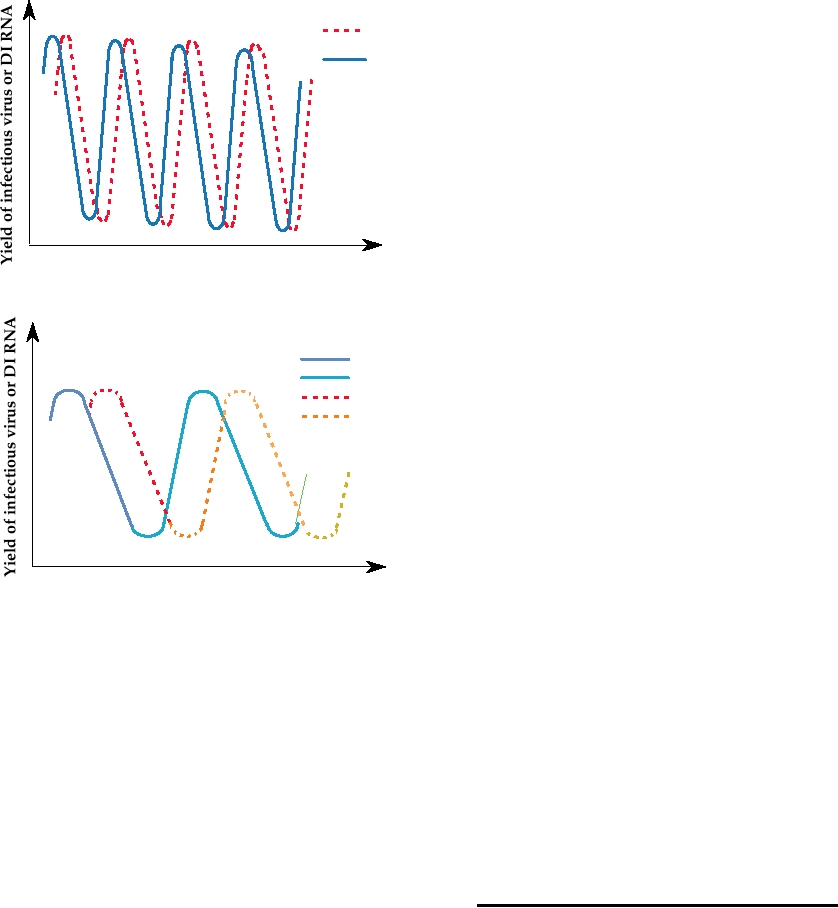A.
Concentration
1
2
1) Early in an undiluted passage series,
of DI RNA
standard virus replicates well, but DI s are
Concentration
beginning to accumulate.
of helper virus
2) DIs replicate at high efficiency, and
interfere with standard virus.
3) So little standard virus is produced that
there is little helper function, and DI
replication drops.
4) With little DI replication, interference is
3
4
reduced and standard virus titers rise again.
Time in days (tens of virus passages)
B.
ST 1
1 ) DI 1 interferes strongly with replication
ST 2
of standard virus (ST1).
I1
2 ) A new variant of standard virus (ST2)
DI 2
emerges that is resistant to interference by
DI 1, and does not serve as a helper for DI 1.
2
1
3 ) Without helper assistance, DI 1
D
4
disappears, and ST 2 replicates vigorously.
3
4 ) New DIs of ST 2 (DI 2) appear and begin
to depress ST 2 replication.
Time in months (hundreds of virus passages)
FIGURE 9.3 Stylized illustration of the influence of defective interfering particles on viral evolution. (A) Short-
term generation of DI particles during undiluted passage and the cyclical fluctuations in infectious virus yield and
concentration of DIs. This effect was first described by von Magnus in 1946 during repeated passage of influenza virus at
high multiplicity. (B) Role of DI particles in driving long-term evolution of viruses. The net result of hundreds of passages
is that variant 2 and its DIs completely replace the original wild type or standard virus 1. Adapted from Encyclopedia of
Viruses, Figure 2 on p. 373.
rapidly takes over the population of virus because of its
actually modulate the virulence of their parents in nature,
selective advantage. However, new DIs then arise that will
and the question remains open.
interfere with the mutant virus, and the cycle repeats.
It is unclear whether DI particles serve a biological role
SATELLITES AND SATELLITE VIRUSES
in nature or whether they are artifacts of abortive recombina-
tion that appear in the laboratory because of the high multi-
plicities of infection that are often used. It has been argued
A number of satellites and satellite viruses are listed
that DIs may arise late in the infection of an animal by a vir-
in Table 9.1. The dependoviruses, a genus in the family
ulent virus and lead to attenuation of symptoms by reducing
Parvoviridae, were considered in Chapter 7. Although the
the yield of infectious virulent virus. As described in earlier
dependoviruses require a helper, the helper is only needed
chapters, such attenuation could be important for the per-
in order to stimulate the cell to enter a stage in which the
sistence of a virus in nature. Hepatitis delta virus, described
dependovirus can replicate. The helper does not provide
later, is a satellite that replicates only in a cell infected by
any function directly related to dependovirus replication or
HBV. Thus, it is clear that it is possible to achieve the mul-
packaging. Satellites and satellite viruses, however, are usu-
tiplicities required to maintain a defective virus in at least
ally more intimately dependent on the presence of a helper
some circumstances. Reconstruction experiments in mice
virus to furnish functions directly required for the replication
have shown that it is possible to attenuate the virulence of
of the satellite genome or for its encapsidation into progeny
lymphocytic choriomeningitis virus by injecting DIs along
particles.
with the virus. However, it is not clear that DIs will arise
Many plant viruses have satellites associated with them.
in an acute infection in time to ameliorate symptoms. Thus,
When a satellite encodes its own coat protein, it is sometimes
it has not been possible to provide firm evidence that DIs
referred to as a satellite virus. Otherwise it is simply called a
Search WWH :


